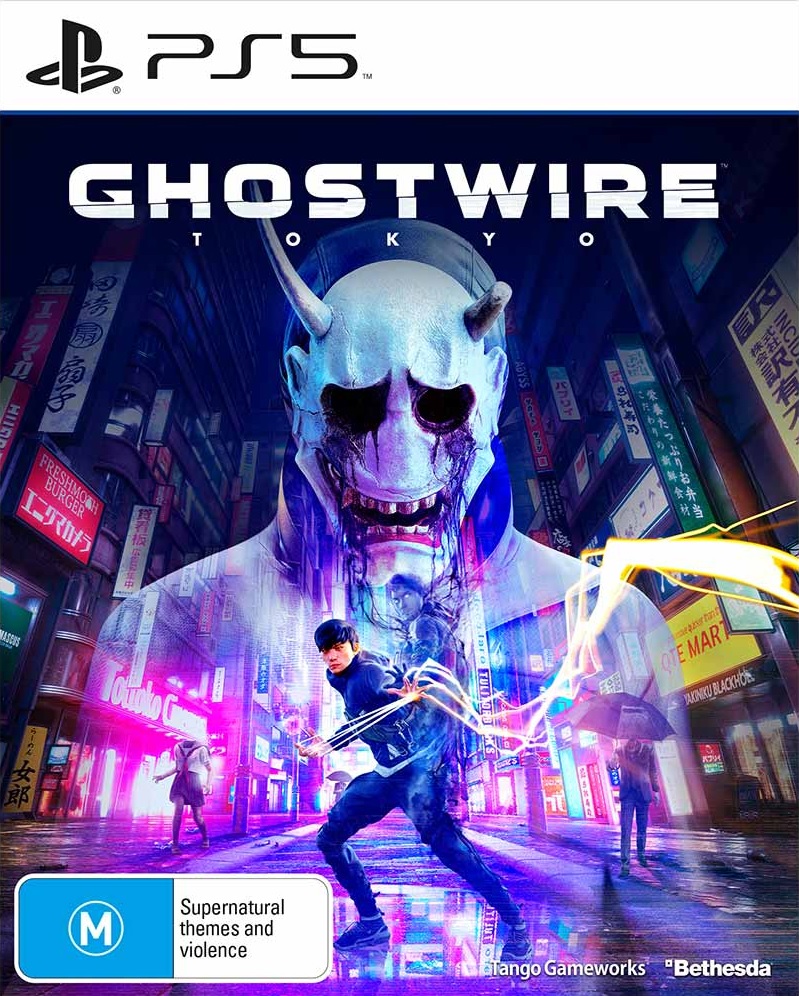Ghostwire: Tokyo
Developer: Tango Gameworks
Publisher: Bethesda
Platforms: PlayStation 5 (Reviewed), PC
Release Date: March 25, 2022
Price: $59.99 USD – Available Here $99.95 AUD – Available Here
Overview
For quite some time Shinji Mikami has been part of some of the biggest games in the industry, especially when it comes to horror games in the late 90s and early 00s. After trying his hand at a variety of other projects since then Mikami’s own studio Tango Gameworks has settled itself nicely into creating unique feeling horror games in the form of The Evil Within and its sequel. Now he has returned with something that is a bit different, taking and delivering a first person action adventure game steeped in Japanese mythology and horror in the form of Ghostwire: Tokyo. By offering a dense multilayered near-open world, gorgeous presentation, and a combat system that both works and feels great to use, it is evident that Tango Gameworks has tapped into some brand new potential here.
Story
For Akito, his life is at an end as a horrible motorcycle crash has left him on death’s door. For everyone else in Shibuya however, things are about to get much worse as a mysterious poisonous fog that instantly eliminates any human that comes into contact with it rolls through the streets of the district turning these once bustling streets into a ghost town. Quite literally in fact as the only beings capable of roaming the streets are hostile “Visitors” that are paranormal manifestations of society’s issues such as total exhaustion, those forced to always wear a smile, hidden rage, and even some spirits that will be incredibly familiar to anyone familiar with Japanese ghost stories.
The mastermind behind this scheme appears as a masked man called Hannya and claims to these spirits that it is time to begin a ritual that will bring the world into a new age. As for Akito, he not only escapes death through the help of the mysterious spirit KK but gains the ability to survive the streets of Shibuya with powerful Ethereal Weaving that he is now capable of using thanks to KK. With Hannya kidnapping Akito’s hospitalized sister, not only must Akito agree to share his body with KK to stay alive but also prevent his only loved one from being used in his ritual.
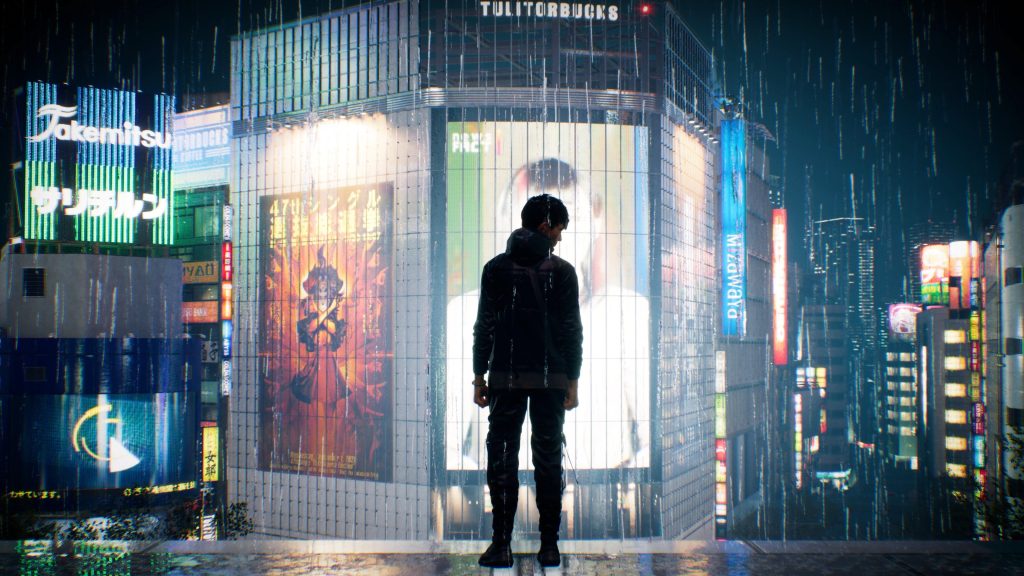
Initially Ghostwire: Tokyo may take a fairly slow pace when it comes to opening up about the various secrets of the world as KK and Akito’s interactions with one another are just shy of hostile at the beginning of the game and Hannya’s plans are kept secret for quite some time. That being said, once the pace begins to pick up players will quickly begin to learn more about KK and his past which also reveals more about the man in the Hannya mask as well as elements of Akito’s own past. Those who stick through the initial slow opening will be treated to quite a few unique twists and turns, especially if they happen to investigate as much as possible around the city.
Not only is the core storyline for the game fairly solid, but the majority of the game’s side-quests are also given a lot of care. As players reveal parts of the map and advance through chapters in the game various spirits will appear asking for some sort of help. These side-quests can be anything from investigating mysterious disappearances or strange noises to flat out tracking down a yōkai though even then these side-quests can end up being rather surprising in nature. Obvious answers to what may have been the cause turn out to be something else entirely while a potentially dangerous threat is instead completely harmless and only wants to be left alone.
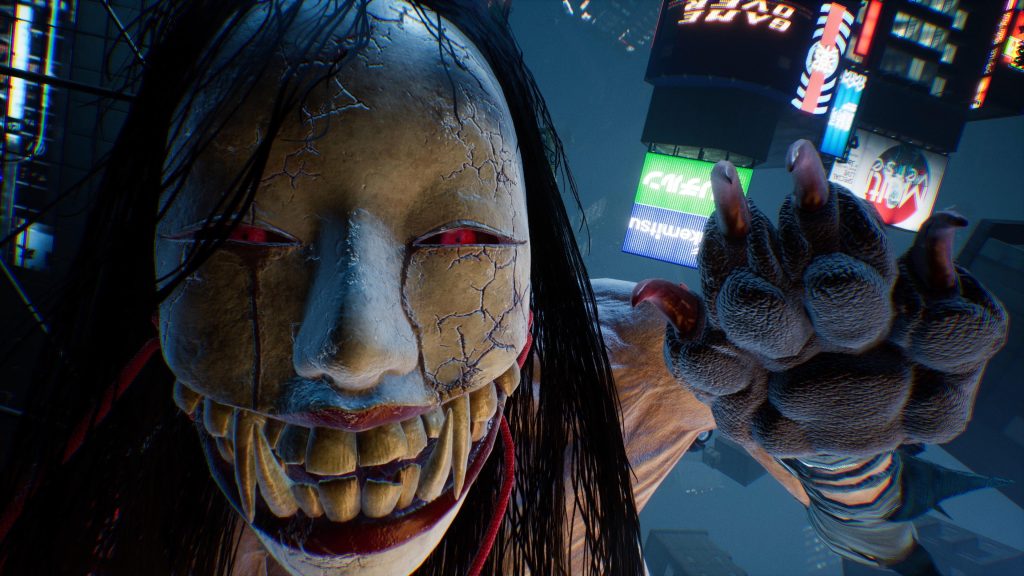
Alongside these side-quests players will also find that there are countless collectables scattered throughout the Shibuya streets and buildings. While most of these collectables are “spirits” that we will mention later on, there are also a large number of Japanese artifacts that range from being historical art pieces or statues to pop culture references such as plastic lizards and super loose socks and of course paranormal ones as well such as knives found around toilets. Nearly every collectible has a detailed explanation to go with it and alongside these there are even various notes from KK’s past investigations, audio recordings, hidden takuni, and more that reveal more about the world and its characters to those willing to explore.
Gameplay
Few could have expected that making a first person action game with elements of horror would work quite so well with players’ primary offense being magic spells but not only does Ghostwire: Tokyo manage to pull it off, it does it with style. When Akito is possessed by KK he can use the power of Ethereal Weaving to attack any hostile Visitors that he encounters. Dealing enough damage to any given Visitor will expose their core that can then be either destroyed by pressing and holding L1 or shot once again to destroy the enemy lest they recover and begin attacking again though should a Visitor recover they will be eliminated instantly the next time their core is exposed.
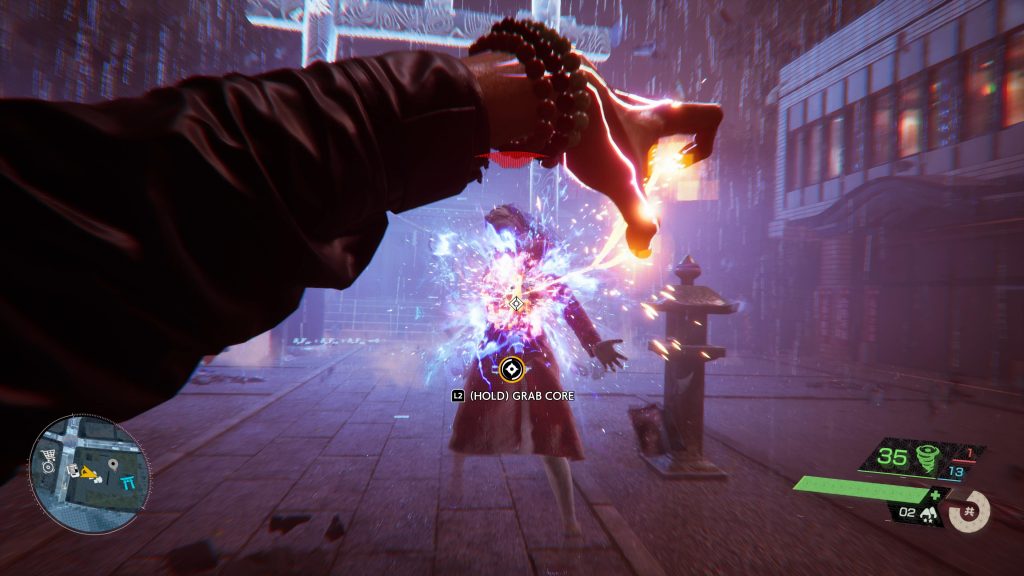
Initially Akito will only have access to a fast-firing wind attack that has an alternative charge attack that fires off two homing wind attacks at an enemy. Eventually players will unlock additional elemental attacks such as Fire that not deals massive damage and can upgraded to pierce through enemies and their defenses and charged to explode after striking its target and Water that sends out a wide-spray of slicing water close to the player and can be upgraded to fire additional slices per attack and charged to deal a wide range of damage to nearby enemies. Players will also eventually gain access to a powerful “Wire In” move that sends out a shockwave and increases the power of all attacks though this move can only be used when players have filled their sync gauge. All of these attacks make use of “Ether” that works as ammunition of sorts and Ether can be obtained both from defeated enemies as well as from destroying abnormal objects that are scattered around the world such as floating or corrupted garbage cans, fuel cans, fans, etc.
Of course, Ethereal Weaving isn’t the only tool that Akito will have access to, especially since there may be moments that he is left to his own devices. Players will quickly gain access to a spiritual bow that can be used to stealthily fire blessed arrows at Visitors and deal large amounts of damage to them and eventually gain access to special talismans that can be used to do a variety of things such as stunning enemies within a certain area or temporarily creating a wall to block the player from being seen and more. Of course, there is also a quick take down method should players sneak up on nearly any enemy in one shot, though a few foes can survive even this stealth takedown. Players can block incoming damage to take a bit less and even perform perfect blocks if timed correctly.
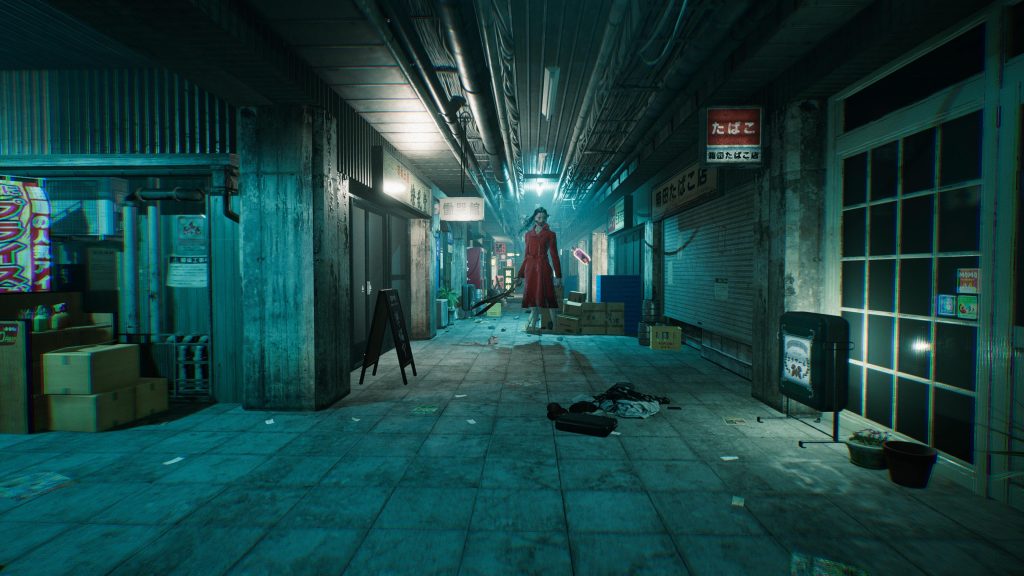
Now while combat may be the most exciting part of Ghostwire: Tokyo, players will be spending almost as much time fighting as they are exploring nearly every inch they can of the world given to them. While not a completely open world game, players are initially limited to navigating to only certain locations thanks to a poisonous fog that has spread throughout the city. Cleansing corrupted Torii gates and shrines will remove large portions of the fog, revealing aforementioned side-quests as well as clearing away large portions of the fog. As mentioned before, the game is absolutely littered with collectibles and one of these that is around nearly every corner and on every rooftop are Spirits.
Since nearly everyone in Shibuya has been vanished away by the fog, their spirits are now floating aimlessly together and occasionally at the mercy of Visitors. With over a hundred thousand to collect these Spirits are everywhere and must be absorbed using Katashiro talismans though it is worth noting that a single absorption can be anywhere from 90 spirits to 800 depending on how difficult a Spirit may be to find or whether they were being attacked. These Spirits are not required by any means but players are rewarded with experience points, the in-game currency meika, and occasionally special story relevant visions when they are returned to special phone booths scattered across the map.
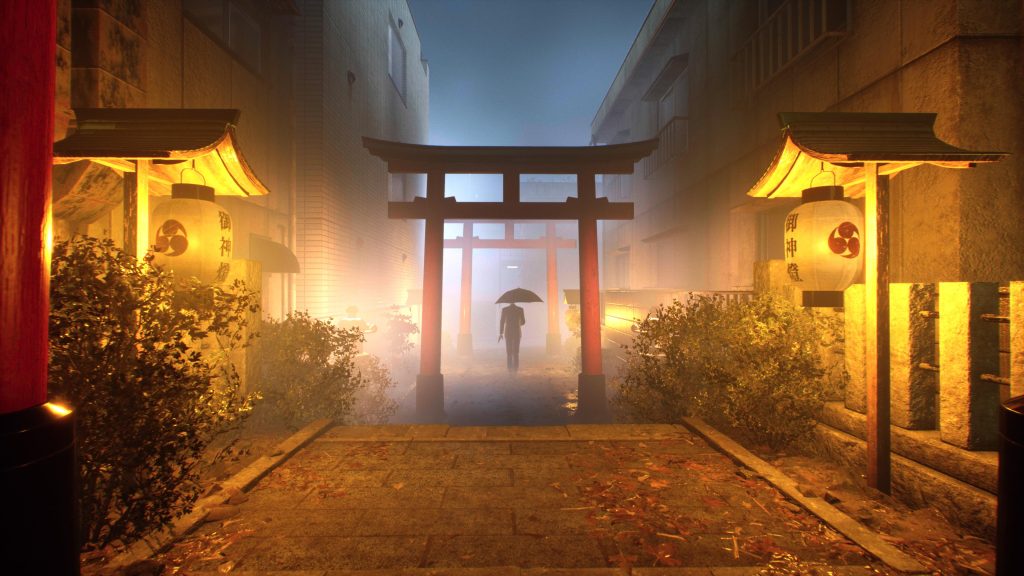
Players will find a variety of things they can spend money on in Ghostwire: Tokyo as the emptiness of the city has allowed hidden Nekomata to emerge and take over various shops and food stalls. These shops allow players to purchase things like additional talismans and arrows, increase the amount of Katashiro they can carry, food to heal, and buy dog food as the other type of creatures that have survived are pets. Dogs still roam the streets and can be pet, fed for an occasional secret or just a small reward, and have their minds read using KK’s spectral vision. Cats can also be talked to and pet, occasionally revealing hidden secrets as well which is a nice touch and it is fun to note that KK can scold the player for spending too much time with animals.
Health is handled in a fairly unique manner in Ghostwire: Tokyo. When players begin the game, they will have a fairly small amount of health to the point that taking even one or two hits may be dangerous but every time the player eats food to recover, their health pool will increase slightly. This means that eating anything from a stick of dango, drinking green tea, or eating a Nether rice ball will increase their overall health as will leveling up. Nether food also can provide temporary buffs, though it is worth noting that actually trying to manage what food the player has equipped and will use is a bit rough.
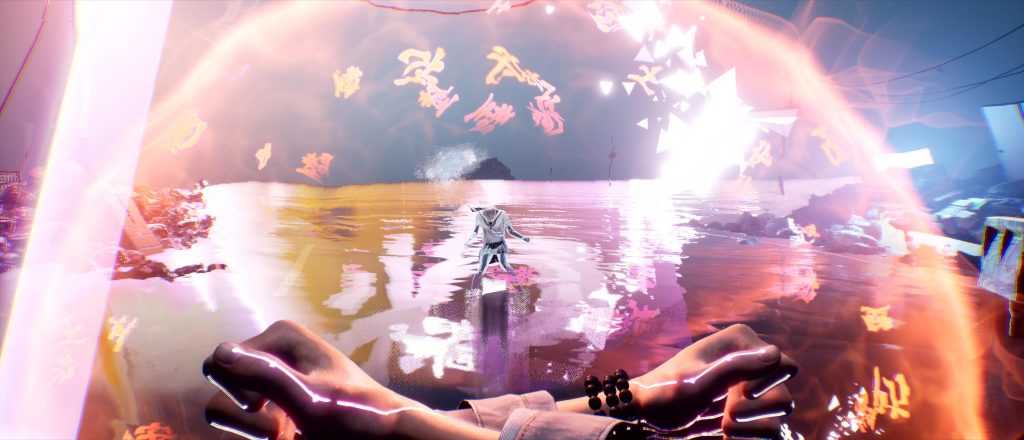
As players fight Visitors, complete quests and side-quests, and transfer spirits they will earn experience points that allow the player to level up and earn skill points. Finding KK’s previous case notes also instantly provides some skill points that can then be used to unlock a variety of upgrades. These range from being able to carry additional items or dealing additional damage with the bow, increasing the firing rate of the Wind weave or explosion radius of the Fire weave and more. Some of these upgrades require additional materials known as Magatama, obtained from capturing the power of yōkai to further upgrade.
Unfortunately, for the most part a large portion of these upgrades feel a bit useless in the long term outside of a few highly recommended ones required for traversal, vision radius, and select combat abilities. These include the ability to glide in the air, giving players the chance to navigate rooftops with a bit more ease, and an expensive but near vital upgrade that allows players to instantly summon a Tengu to their location and grapple onto it allowing for the immediate climbing of most buildings. While these Tengu are harmless to the player and found in many areas, being able to summon their own is a massive help.
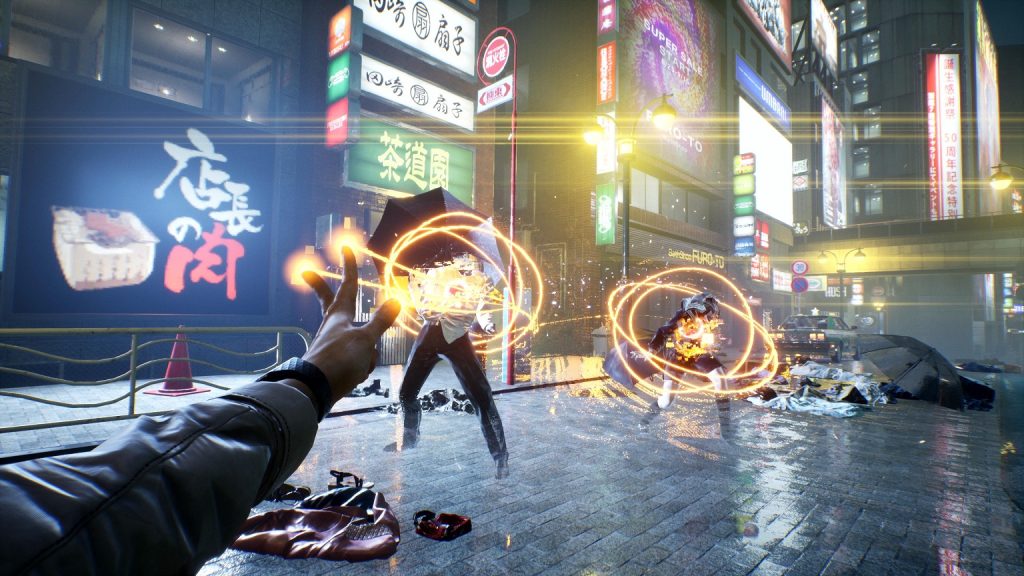
The reason for most of these navigation upgrades is that the world of Ghostwire: Tokyo is incredibly dense. Nearly every alleyway will feel like there is something located inside of it, be it a collectible, Spirit, or simply money and many buildings will also have special locations on top of them that simply are easier to reach with a few extra upgrades, especially since there is no fall damage. Players can easily sink countless hours delving through every square inch of Shibuya in the game and probably still miss out on something, though the game can provide a few hints here and there at Shrines that feature donation boxes.
Tango Gameworks has made great use of the PlayStation 5’s Dualsense controller as not only are players able to feel the firing off of their Ethereal Weaves through the trigger haptics as well as when using the bow but raindrops also cause a slight rumble whenever it rains, which is quite often and a nice touch. The controller’s speaker also gets a lot of work as it makes an eerie noise when Visitors are nearby, chimes when the player’s Spectral Sense picks up a shrine, and even meows when near a collectible. In fact, KK will often speak through both the player’s television as well as the controller to help drive home the fact he is a spirit inhabiting Akito.
Visuals & Audio
It will quickly become evident to those playing on the PlayStation 5 that Ghostwire: Tokyo is an absolutely gorgeous game, especially if players choose to select one of the many graphics options available that focuses on ray tracing. The city of Shibuya is recreated in outstanding fashion to the point that the neon glow reflects off puddles while the eerie nature of the Visitors and spiritual beings from horror stories are replicated greatly here. Combat is also presented excellently as Akito’s hand movements to fire off his weave attacks are similar to those from kung fu moves while the weaves themselves look great when striking opponents.

The game will automatically default players to the Japanese voice track with English subtitles and this works incredibly well, especially with how steeped in Japanese mythology and supernatural the game is, though those who simply want to listen to the game in English will find a perfectly handled English dub as well. The soundtrack features a solid mix of tracks that fit the style of the game perfectly including a number of tracks that work exceptionally well during the more tense moments that arise from time to time.
Overall
There came a lot of risks with taking a game as large as Ghostwire: Tokyo and going all out with it but Tango Gameworks has pulled it off. Not only does the game feature some outstanding combat set in a densely packed city that players can spend hours searching through but it delivers a solid storyline with plenty of enjoyable side content as well. It may lack a bit in rewarding player upgrades and take a bit to get going but once it does, players will find they are in for quite a treat, especially if they have any interest in Japanese mythology.
Capsule Computers review guidelines can be found here.


